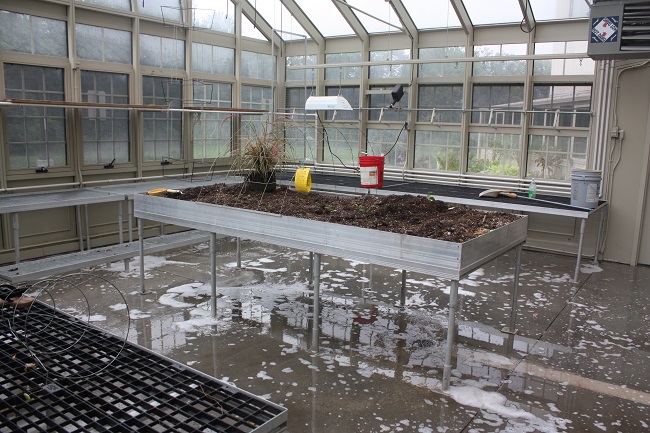
As the cold weather approaches, greenhouse growers should begin preparing their greenhouses for the winter. Before bringing in the plants from outside, a good sanitizing of the greenhouse and the plants themselves is recommended. This can be viewed as a yearly maintenance and preventative procedure which can greatly reduce the likelihood of problems during the winter months. A good cleaning combined with proper placement of the plants in the greenhouse equates to a smoother transition into next year’s growing season.
Sanitizing the Greenhouse
Before moving plants into the greenhouse for overwintering, it is a good idea to thoroughly clean the greenhouse. Start by removing any plants that are currently in the greenhouse. After the greenhouse is empty, hose down the entire greenhouse with soapy water. In most cases, soapy water is enough to prevent algae build up on the glaze or framing of the greenhouse. If algae have already built up, a good pressure wash can easily rectify the problem. It is very important for owners of polycarbonate greenhouses to avoid using window cleaners of any kind. Window cleaners can damage the polycarbonate panels and make them less transparent.
After using soapy water and/or the pressure washer, it is a good idea to further sanitize the greenhouses with a sterilizing/sanitizing agent. A diluted bleach solution is one sanitizing agent commonly in greenhouses. However, there are two distinct disadvantages to using a bleach solution. First, the odor and fumes created by bleach can be overwhelming, especially when used in a contained area like a greenhouse. Second, a diluted bleach solution works fine for sanitizing the greenhouse itself but should not be used on the plants that will be coming into the greenhouse from outside. Even a diluted bleach solution would be harmful to the plants. Molds and pathogens often enter the greenhouse by hitching a ride on a plant or in the soil of a plant brought in from outside.
A good solution to this is a cleaning agent that is Physan 20 is an algaecide, fungicide, bactericide, and virucide. In other words, Physan 20 helps fight algae, fungi, bacteria, and viruses. After washing the greenhouse with soapy water, an application of Physan 20 will kill any remaining fungi, algae, bacteria, or viruses. Physan 20 is virtually odorless which makes it much easier to work with than a diluted bleach solution. Perhaps the largest advantage of Physan 20 is its ability to be used directly on ornamental plants and their soil. Physan 20 can be used as a soil drench to kill any pathogenic fungi, bacteria, algae, or viruses lurking in the soil of plants kept outdoors. Physan 20 comes in a concentrate form and must be diluted before use. Horticulturists should pay close attention to the manufacturer’s recommended dilution rates for the various uses of the product. In other words, the recommended concentration for cleaning the greenhouse material will differ from the concentration for a soil drench.
Preparing the Plants for Overwintering
Before bringing outside plants into the greenhouse for the winter, a gardener should take a few steps to make the transition smoother. Start with cleaning the plants themselves by removing any dead or dying leaves from the plant and soil container. Examine the plants closely for pest insects. Any pest insect issues should be treated before bringing those plants into the greenhouse. If possible, time watering the plants so they can receive a watering with the Physan 20 mixture right before entering the greenhouse for the winter. As previously mentioned, this will kill any fungi, algae, bacteria, or viruses that may be contained in the soil.
Plant Placement
Plant placement is another important factor to consider when overwintering. Some plants are more sensitive to cold than others. The plants that will better handle cold conditions should be placed along the perimeter of the greenhouse and those more sensitive to the cold should be placed closer to the center. If the plan is to grow orchids or food crops, the greenhouse will need to be heated by some sort of heating device to keep the ambient air temperature warm enough for flower/fruit production. This article gives your information on how to heat a greenhouse without electricity.
Sanitizing the greenhouse is an important preventive measure that can be the difference between a smooth transition and a catastrophe come spring. Cleaning and sanitizing the plants before they enter the greenhouse is a vital step to keep the plants healthy and happy all winter long. Proper plant placement is another crucial factor contributing to the heath of the plants. When planning the layout of the greenhouse for winter, do not forget to leave some space for next spring’s seedings. After all, winter will be over before you know it and the next chapter of your garden will soon begin.
Background information for this article was provided by Arcadia GlassHouse. For more information visit ArcadiaGlasshouse.com.
Related Articles & Free Email Newsletter Sign Up
4 Things You Need to Know Before Building a Greenhouse
Active Solar Heating for Greenhouses
Passive Solar Heating for Greenhouse Operations




Comment here